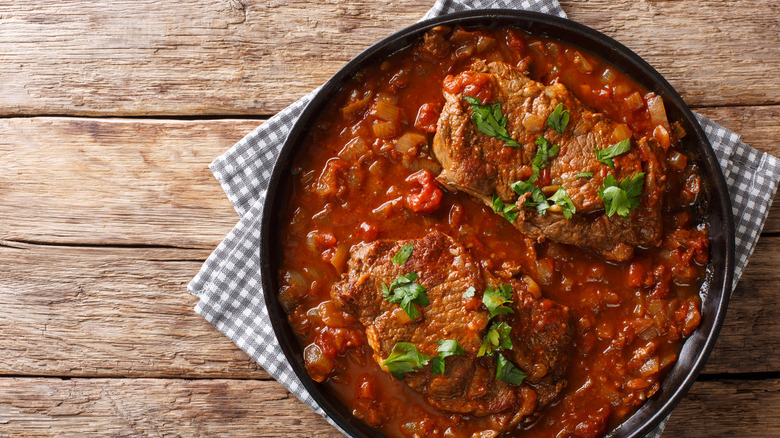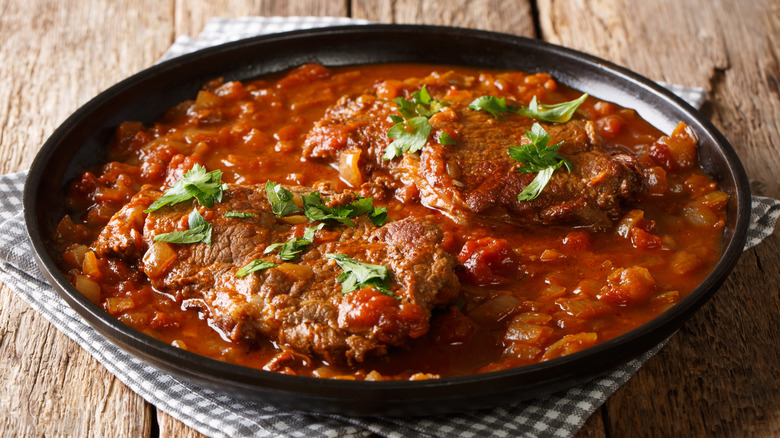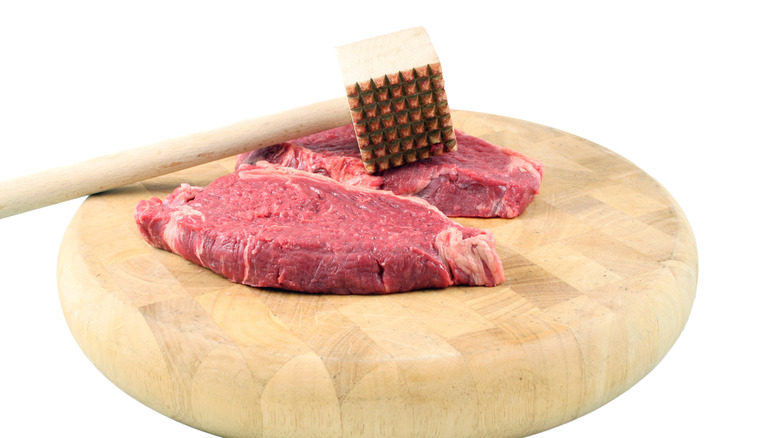Swiss Steak Is Probably Not What You Think It Is
If you've ever dined on the saucy, hearty meal that is Swiss steak, you may have thought you were dining on traditional Swiss food. However, if you try to order the meal in Switzerland, you will probably get more than a few puzzled glances. It turns out that Swiss steak doesn't originate from Switzerland, despite what the name implies and what many diners may have expected. Fun fact: French fries also don't originate from France.
A Swiss steak takes the heartiness and savoriness of beef and combines it with the sweet tanginess of tomatoes and onions. The meat is cooked in a tomato sauce that conjures up some of the greatest Italian dishes, but nope, the dish doesn't originate from there, either. It's an American classic, which we will get to in a minute. So, why is the smothered steak called a Swiss steak? Does it have holes in the meat like Swiss cheese? Well, the meal actually gets its title from the way that the meat is tenderized.
For a Swiss steak meal, you probably shouldn't utilize a cut of Wagyu steak or even a ribeye, as those steaks are best served seared. Typically, the meal is made with less expensive cuts of meat, i.e. slightly tougher cuts that are harder to chew. Think bottom round or chuck, for instance. Traditionally, these steak cuts were run through a tenderizing machine called a swisser.
How to swiss a steak
In order to Swiss the steak, the tougher cuts are run through an electric meat tenderizer. This machine leaves indentations on the meat in the shape of small cubes. Swiss steak is also known by many as cube steak for this very reason. So you may have had Swiss steak without realizing it. However, if you don't have a swisser or electric meat tenderizer on hand, then you can still make Swiss steak manually. All you need is a handy-dandy meat mallet, which also has cubed prongs to smash the meat.
To tenderize or swiss your steak, place the meat between two pieces of parchment paper. From there, unleash your inner Thor and smash the steaks until they're nice and tenderized. Just don't overdo it — you don't want to be frying up beef pulp. If you would like to try Swiss steak but don't feel like getting your hands dirty, then there are alternative ways of achieving the desired tenderness — although the steak technically wouldn't be a Swiss steak by definition.
You can use a slow cooker to help tenderize the meat, the heat of which breaks down the connective tissues and softens tough muscle fibers. While it may take longer to cook, the steaks will be just as tender with the added benefit of having a longer time to marinate in your sauces.
Origins of Swiss steak
Despite the moniker, it appears that the Swiss steak is American in origin. The exact beginnings of this take on steak are clouded in mystery. However, we do know that Swiss steak first started popping up around 1915. However, at the time, the meal didn't feature the tomato sauce base that it would later become known for.
It was John Mariani's "The Encyclopedia of American Food and Wine" that first mentions Swiss steak in relation to the swissing method of tenderizing food. The meal didn't become particularly popular until the 1940s and '50s, thanks in part to Reynolds Wrap Aluminium. The aluminum foil company promoted the recipe as a quick and easy, clean-up-free dinner, and thus the meal became a hit with families looking for convenience. The company suggested lining the bottom of pans with aluminum foil to save on cleaning time.
As for the longevity of the Swiss steak recipe, one has to look to the Better Homes and Gardens cookbooks. These cookbooks, a staple for a time in many houses, often included the recipe as well. So, while it may be called a Swiss steak, the meal has origins in the United States.


